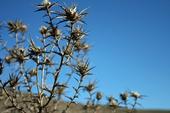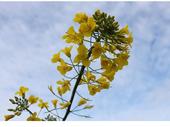- Author: Guy B Kyser

Woolly distaff thistle (Carthamus lanatus L.) is a yellow-flowered, spiny winter annual native to Mediterranean and central Europe. It has become a problem recently in northern California and southern Oregon. Ranchers in Marin County are reporting populations of distaff thistle so dense that they crowd out grasses and native species. The populations appear to spread along an elevation gradient, maybe along cattle trails.
Organic growers have tried mowing distaff prior to flowering. This sets it back, but is not a long-term solution – not to mention the difficulties of mowing on steep hillsides. In one area, ranchers conducted a prescribed burn in June, which prevented thistle from producing any seed...
- Author: Douglas J Munier

Previously in this blog Brad Hanson discussed some of the research Kent Brittan (UCCE Yolo) and I have done with Roundup Ready canola as a crop and then evaluating it as a weed because of its seed dormancy characteristics. We published an article on the weediness potential of Roundup Ready canola in California this past January in the Journal of Environmental Science and Pollution Research.
Here's the abstract from the article:
Abstract: Canola which is genetically modified (GM) for tolerance to glyphosate has the potential to become established as a new glyphosate resistant weed, thus reducing the effectiveness of glyphosate. Volunteer from dormant canola seeds produced thousands of plants per acre...
- Author: Joseph DiTomaso
The Weed Research and Information Center previously produced three instructional videos intended for the general public, or more specifically, the Master Gardener program. These videos focused on weed identification tools, principles of urban weed control, and urban weed control tools. In this fourth video, the emphasis is on wildland weed management. The 35+ minute video discusses the different formulations used in wildland weed management,...
- Posted by: Gale Perez
- Author: Elizabeth Brusati

CalWeedMapper is a new website for mapping invasive plant spread and planning regional management strategies (calweedmapper.calflora.org). Users generate a report for their region that synthesizes information into three types of strategic opportunities: surveillance, eradication and containment. Land managers can use these reports to prioritize their invasive plant management, to coordinate at the landscape level (county or larger) and to justify funding requests. For some species, CalWeedMapper also provides maps of suitable range that show where a plant might be able to grow in the future. The system was developed by the California Invasive Plant Council (Cal-IPC,
- Author: Brad Hanson
Reposting a conference announcement:
A conference entitled, “Educating the Public about New Invasive Species Threatening California’s Plant Ecosystems”, will be held on Tuesday, April 24, 2012, at the University of California, Davis Conference Center.
The goal of this conference is to bring together biologists, social scientists, and communication experts to discuss how to educate all segments of society about the threat of invasive species and how to assist in their exclusion and detection. The conference will examine pest plants and plant pests that are likely to enter California in the near future, the pathways of introduction and likelihood of entry, and examples of...


